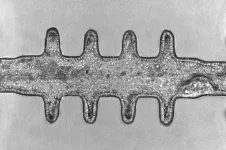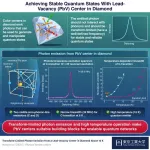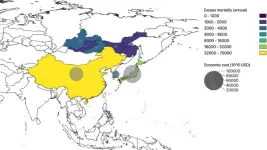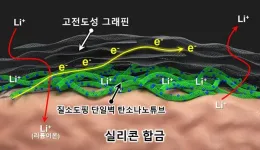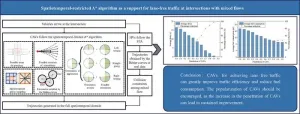(Press-News.org) Images
The most up-to-date understanding of the flowering plant tree of life is presented in a new study published today in the journal Nature by an international team of 279 scientists, including three University of Michigan biologists.
Using 1.8 billion letters of genetic code from more than 9,500 species covering almost 8,000 known flowering plant genera (ca. 60%), this achievement sheds new light on the evolutionary history of flowering plants and their rise to ecological dominance on Earth.
Led by scientists at the Royal Botanic Gardens, Kew, the research team believes the data will aid future attempts to identify new species, refine plant classification, uncover new medicinal compounds, and conserve plants in the face of climate change and biodiversity loss.
The major milestone for plant science, involving 138 organizations internationally, was built on 15 times more data than any comparable studies of the flowering plant tree of life. Among the species sequenced for this study, more than 800 have never had their DNA sequenced before.
The sheer amount of data unlocked by this research, which would take a single computer 18 years to process, is a huge stride toward building a tree of life for all 330,000 known species of flowering plants—a massive undertaking by Kew's Tree of Life Initiative.
"Analyzing this unprecedented amount of data to decode the information hidden in millions of DNA sequences was a huge challenge. But it also offered the unique opportunity to reevaluate and extend our knowledge of the plant tree of life, opening a new window to explore the complexity of plant evolution," said Alexandre Zuntini, a research fellow at Royal Botanic Gardens, Kew.
Tom Carruthers, postdoctoral researcher in the lab of U-M evolutionary biologist Stephen Smith, is co-lead author of the study with Zuntini, who he previously worked with at Kew. U-M plant systematist Richard Rabeler is a co-author.
"Flowering plants feed, clothe and greet us whenever we walk into the woods. The construction of a flowering plant tree of life has been a significant challenge and goal for the field of evolutionary biology for more than a century," said Smith, co-author of the study and professor in the U-M Department of Ecology and Evolutionary Biology. "This project moves us closer to that goal by providing a massive dataset for most of the genera of flowering plants and offering one strategy to complete this goal."
Smith had two roles on the project. First, members of his lab—including former U-M graduate student Drew Larson—traveled to Kew to help sequence members of a large and diverse plant group called Ericales, which includes blueberries, tea, ebony, azaleas, rhododendrons and Brazil nuts.
Second, Smith supervised the analyses and construction of the project dataset along with William Baker and Felix Forest of the Royal Botanic Gardens, Kew, and Wolf Eisenhardt of Aarhus University.
"One of the biggest challenges faced by the team was the unexpected complexity underlying many of the gene regions, where different genes tell different evolutionary histories. Procedures had to be developed to examine these patterns on a scale that hadn't been done before," said Smith, who is also director of the Program in Biology and an associate curator in biodiversity informatics at the U-M Herbarium.
As co-leader of the study, Carruthers' main responsibilities included scaling the evolutionary tree to time using 200 fossils, analyzing the different evolutionary histories of the genes underlying the overall evolutionary tree, and estimating rates of diversification in different flowering plant lineages at different times.
"Constructing such a large tree of life for flowering plants, based on so many genes, sheds light on the evolutionary history of this special group, helping us to understand how they came to be such an integral and dominant part of the world," Carruthers said. "The evolutionary relationships that are presented—and the data underlying them—will provide an important foundation for a lot of future studies."
The flowering plant tree of life, much like our own family tree, enables us to understand how different species are related to each other. The tree of life is uncovered by comparing DNA sequences between different species to identify changes (mutations) that accumulate over time like a molecular fossil record.
Our understanding of the tree of life is improving rapidly in tandem with advances in DNA sequencing technology. For this study, new genomic techniques were developed to magnetically capture hundreds of genes and hundreds of thousands of letters of genetic code from every sample, orders of magnitude more than earlier methods.
A key advantage of the team's approach is that it enables a wide diversity of plant material, old and new, to be sequenced, even when the DNA is badly damaged. The vast treasure troves of dried plant material in the world's herbarium collections, which comprise nearly 400 million scientific specimens of plants, can now be studied genetically.
"In many ways this novel approach has allowed us to collaborate with the botanists of the past by tapping into the wealth of data locked up in historic herbarium specimens, some of which were collected as far back as the early 19th century," said Baker, senior research leader for Kew's Tree of Life Initiative.
"Our illustrious predecessors, such as Charles Darwin or Joseph Hooker, could not have anticipated how important these specimens would be in genomic research today. DNA was not even discovered in their lifetimes. Our work shows just how important these incredible botanical museums are to groundbreaking studies of life on Earth. Who knows what other undiscovered science opportunities lie within them?"
Across all 9,506 species sequenced, more than 3,400 came from material sourced from 163 herbaria in 48 countries.
"Sampling herbarium specimens for the study of plant relationships makes broad sampling from diverse areas of the world much more feasible than if one had to travel to get fresh material from the field," said U-M's Rabeler, a research scientist emeritus and former collection manager at the U-M Herbarium.
For the tree of life project, Rabeler helped verify the identity of herbarium specimens selected for sampling and analyzed the resulting data.
Flowering plants alone account for about 90% of all known plant life on land and are found virtually everywhere on the planet—from the steamiest tropics to the rocky outcrops of the Antarctic Peninsula. And yet, our understanding of how these plants came to dominate the scene soon after their origin has baffled scientists for generations, including Darwin.
Flowering plants originated more than 140 million years ago after which they rapidly overtook other vascular plants including their closest living relatives—the gymnosperms (nonflowering plants that have naked seeds, such as cycads, conifers and ginkgo).
Darwin was mystified by the seemingly sudden appearance of such diversity in the fossil record. In an 1879 letter to Hooker, his close confidant and director of the Royal Botanic Gardens, Kew, he wrote: "The rapid development as far as we can judge of all the higher plants within recent geological times is an abominable mystery."
Using 200 fossils, the authors scaled their tree of life to time, revealing how flowering plants evolved across geological time. They found that early flowering plants did indeed explode in diversity, giving rise to more than 80% of the major lineages that exist today shortly after their origin.
However, this trend then declined to a steadier rate for the next 100 million years until another surge in diversification about 40 million years ago, coinciding with a global decline in temperatures. These new insights would have fascinated Darwin and will surely help today's scientists grappling with the challenges of understanding how and why species diversify.
Assembling a tree of life this extensive would have been impossible without Kew's scientists collaborating with many partners across the globe. In total, 279 authors were involved in the research, representing many different nationalities from 138 organizations in 27 countries.
"The plant community has a long history of collaborating and coordinating molecular sequencing to generate a more comprehensive and robust plant tree of life. The effort that led to this paper continues in that tradition but scales up quite significantly," said U-M's Smith.
The flowering plant tree of life has enormous potential in biodiversity research. This is because, just as one can predict the properties of an element based on its position in the periodic table, the location of a species in the tree of life allows us to predict its properties. The new data will thus be invaluable for enhancing many areas of science and beyond.
To enable this, the tree and all of the data that underpin it have been made openly and freely accessible to both the public and scientific community, including through the Kew Tree of Life Explorer.
Open access will help scientists to make the best use of the data, such as combining it with artificial intelligence to predict which plant species may include molecules with medicinal potential.
Similarly, the tree of life can be used to better understand and predict how pests and diseases are going to affect plants in the future. Ultimately, the authors note, the applications of this data will be driven by the ingenuity of the scientists accessing it.
Study: Phylogenomics and the rise of the Angiosperms (DOI: 10.1038/s41586-024-07324-0)
Written by Royal Botanic Gardens, Kew.
END
Vast DNA tree of life for flowering plants revealed by global science team
Scientists use 1.8 billion letters of genetic code to build groundbreaking tree of life
2024-04-24
ELSE PRESS RELEASES FROM THIS DATE:
Mini-colons revolutionize colorectal cancer research
2024-04-24
As our battle against cancer rages on, the quest for more sophisticated and realistic models to study tumor development has never been more critical. Until now, research has relied on animal models and simplified cell culture methods, which are valuable but cannot fully capture the complex interplay of factors involved in tumor development.
Even newer, more advanced models for studying cancer, such as organoids – tiny, lab-grown versions of organs – do not faithfully replicate the cell behaviors and tissue architectures seen in actual tumors.
This gap has significantly hindered our understanding ...
Lead-vacancy centers in diamond as building blocks for large-scale quantum networks
2024-04-24
Much like how electric circuits use components to control electronic signals, quantum networks rely on special components and nodes to transfer quantum information between different points, forming the foundation for building quantum systems. In the case of quantum networks, color centers in diamond, which are defects intentionally added to a diamond crystal, are crucial for generating and maintaining stable quantum states over long distances.
When stimulated by external light, these color centers in diamond emit photons carrying information about their internal electronic states, especially the spin states. The interaction between the emitted photons and the ...
JMIR Rehabilitation and Assistive Technologies announces theme issue on participatory methods in rehabilitation research
2024-04-24
JMIR Publications invites submissions to a new theme issue titled “Incorporating Participatory Methods in Developing, Implementing, and Evaluating Rehab Interventions and Assistive Technologies” in its premier, open access journal JMIR Rehabilitation and Assistive Technologies (JRAT).
JRAT is a peer-reviewed journal indexed in PubMed and PubMed Central, SCOPUS, DOAJ, Web of Science, Sherpa Romeo, and EBSCO and EBSCO Essentials. This theme issue aims to showcase research that actively engages patients, caregivers, and other stakeholders (knowledge users) ...
SwRI’s Dr. Marc Janssens recognized for role in establishing cone calorimeter fire testing
2024-04-24
SAN ANTONIO — April 24, 2024 — Southwest Research Institute’s Dr. Marc Janssens was named a “DiNenno Prize Laureate” for his role in the widespread adoption of the cone calorimeter, a fire-testing tool that accurately measures heat release and material flammability. The National Fire Protection Association® recognized the cone calorimeter with the 2024 Philip J. DiNenno Prize for its lasting impact on fire safety. Dr. Vytenis Babrauskas, a co-recipient of the prize, developed the cone ...
Modeling broader effects of wildfires in Siberia
2024-04-24
As wildfires in Siberia become more common, global climate modeling estimates significant impacts on climate, air quality, health, and economies in East Asia and across the northern hemisphere.
The global effects of increasing wildfires in Siberia have been modeled by researchers at Hokkaido University and colleagues at the University of Tokyo and Kyushu University. The results, published in the journal Earth’s Future, suggest significant and widespread effects on air quality, climate, health, and economics under the most extreme wildfire scenarios.
The authors performed global numerical simulation experiments to evaluate how the increased intensity of wildfires ...
Researchers find oldest undisputed evidence of Earth’s magnetic field
2024-04-24
A new study, led by the University of Oxford and MIT, has recovered a 3.7-billion-year-old record of Earth’s magnetic field, and found that it appears remarkably similar to the field surrounding Earth today. The findings have been published today in the Journal of Geophysical Research.
Without its magnetic field, life on Earth would not be possible since this shields us from harmful cosmic radiation and charged particles emitted by the Sun (the ‘solar wind’). But up to now, there has been no reliable date for when the modern magnetic field was first established.
In the new study, the researchers examined ...
Eric and Wendy Schmidt announce 2024 Schmidt Science Fellows
2024-04-24
Eric and Wendy Schmidt Announce 2024 Schmidt Science Fellows
32 exceptional early career researchers will tackle ambitious interdisciplinary science projects
The seventh cohort of the interdisciplinary program, an initiative of Schmidt Sciences, will advance research in areas ranging from healthcare and the environment to advanced materials and robotics
The 2024 Fellows, representing 17 nationalities from 26 nominating institutions across North America, Europe, and Asia, will also benefit from bespoke ...
Paclitaxel-induced immune dysfunction and activation of transcription factor AP-1 facilitate Hepatitis B virus replication
2024-04-24
Background and Aims
Hepatitis B virus (HBV) reactivation is commonly observed in individuals with chronic HBV infection undergoing antineoplastic drug therapy. Paclitaxel (PTX) treatment has been identified as a potential trigger for HBV reactivation. This study aimed to uncover the mechanisms of PTX-induced HBV reactivation in vitro and in vivo, which may inform new strategies for HBV antiviral treatment.
Methods
The impact of PTX on HBV replication was assessed through various methods including enzyme-linked immunosorbent assay, dual-luciferase reporter assay, quantitative ...
Single-walled carbon nanotubes doped with ‘nitrogen’ enhance the performance of secondary battery anode
2024-04-24
Dr. Han Joong Tark and student researcher Lee Do Geun at the Nano Hybrid Technology Research Center of Korea Electrotechnology Research Institute(KERI) have developed a new manufacturing technique for "silicon/nitrogen-doped carbon composite anode materials." These materials aim to enhance the capacity and stability of lithium-ion battery anodes.
Silicon, despite offering significantly higher energy density compared to graphite (a common anode material), suffers from a major drawback: it expands 3-4 times during charging and discharging, leading to performance degradation. To address this issue, researchers are blending ...
Pioneering the future of urban traffic: The revolutionary spatiotemporal-restricted a* algorithm
2024-04-24
As urban areas continue to grow, the demand for innovative solutions to alleviate traffic congestion and improve transportation efficiency has never been more urgent. A recent breakthrough study presented by researchers from the Shanghai Artificial Intelligence Laboratory as well as international research team introduces a cutting-edge approach to managing traffic at urban intersections using the spatiotemporal-restricted A* algorithm. This advanced method promises to transform how traffic is handled by optimizing the flow of both connected automated vehicles (CAVs) and human-driven vehicles (HVs) ...
LAST 30 PRESS RELEASES:
Why nail-biting, procrastination and other self-sabotaging behaviors are rooted in survival instincts
Regional variations in mechanical properties of porcine leptomeninges
Artificial empathy in therapy and healthcare: advancements in interpersonal interaction technologies
Why some brains switch gears more efficiently than others
UVA’s Jundong Li wins ICDM’S 2025 Tao Li Award for data mining, machine learning
UVA’s low-power, high-performance computer power player Mircea Stan earns National Academy of Inventors fellowship
Not playing by the rules: USU researcher explores filamentous algae dynamics in rivers
Do our body clocks influence our risk of dementia?
Anthropologists offer new evidence of bipedalism in long-debated fossil discovery
Safer receipt paper from wood
Dosage-sensitive genes suggest no whole-genome duplications in ancestral angiosperm
First ancient human herpesvirus genomes document their deep history with humans
Why Some Bacteria Survive Antibiotics and How to Stop Them - New study reveals that bacteria can survive antibiotic treatment through two fundamentally different “shutdown modes”
UCLA study links scar healing to dangerous placenta condition
CHANGE-seq-BE finds off-target changes in the genome from base editors
The Journal of Nuclear Medicine Ahead-of-Print Tip Sheet: January 2, 2026
Delayed or absent first dose of measles, mumps, and rubella vaccination
Trends in US preterm birth rates by household income and race and ethnicity
Study identifies potential biomarker linked to progression and brain inflammation in multiple sclerosis
Many mothers in Norway do not show up for postnatal check-ups
Researchers want to find out why quick clay is so unstable
Superradiant spins show teamwork at the quantum scale
Cleveland Clinic Research links tumor bacteria to immunotherapy resistance in head and neck cancer
First Editorial of 2026: Resisting AI slop
Joint ground- and space-based observations reveal Saturn-mass rogue planet
Inheritable genetic variant offers protection against blood cancer risk and progression
Pigs settled Pacific islands alongside early human voyagers
A Coral reef’s daily pulse reshapes microbes in surrounding waters
EAST Tokamak experiments exceed plasma density limit, offering new approach to fusion ignition
Groundbreaking discovery reveals Africa’s oldest cremation pyre and complex ritual practices
[Press-News.org] Vast DNA tree of life for flowering plants revealed by global science teamScientists use 1.8 billion letters of genetic code to build groundbreaking tree of life
